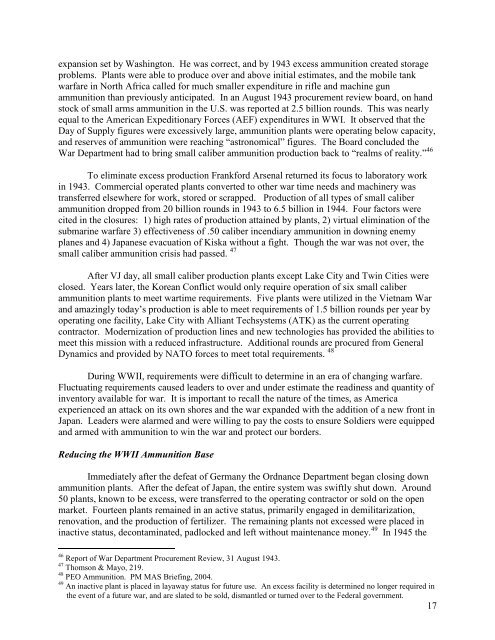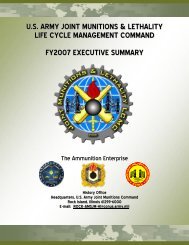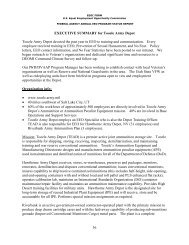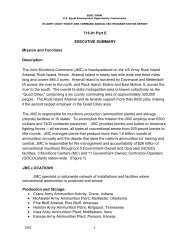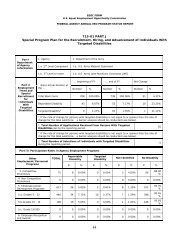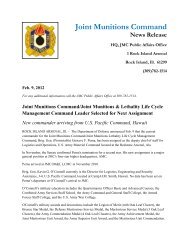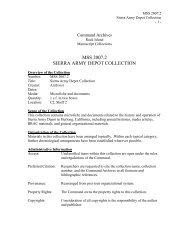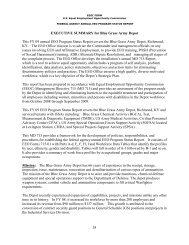History of the Ammunition Industrial Base - JMC - U.S. Army
History of the Ammunition Industrial Base - JMC - U.S. Army
History of the Ammunition Industrial Base - JMC - U.S. Army
Create successful ePaper yourself
Turn your PDF publications into a flip-book with our unique Google optimized e-Paper software.
expansion set by Washington. He was correct, and by 1943 excess ammunition created storage<br />
problems. Plants were able to produce over and above initial estimates, and <strong>the</strong> mobile tank<br />
warfare in North Africa called for much smaller expenditure in rifle and machine gun<br />
ammunition than previously anticipated. In an August 1943 procurement review board, on hand<br />
stock <strong>of</strong> small arms ammunition in <strong>the</strong> U.S. was reported at 2.5 billion rounds. This was nearly<br />
equal to <strong>the</strong> American Expeditionary Forces (AEF) expenditures in WWI. It observed that <strong>the</strong><br />
Day <strong>of</strong> Supply figures were excessively large, ammunition plants were operating below capacity,<br />
and reserves <strong>of</strong> ammunition were reaching “astronomical” figures. The Board concluded <strong>the</strong><br />
War Department had to bring small caliber ammunition production back to “realms <strong>of</strong> reality.” 46<br />
To eliminate excess production Frankford Arsenal returned its focus to laboratory work<br />
in 1943. Commercial operated plants converted to o<strong>the</strong>r war time needs and machinery was<br />
transferred elsewhere for work, stored or scrapped. Production <strong>of</strong> all types <strong>of</strong> small caliber<br />
ammunition dropped from 20 billion rounds in 1943 to 6.5 billion in 1944. Four factors were<br />
cited in <strong>the</strong> closures: 1) high rates <strong>of</strong> production attained by plants, 2) virtual elimination <strong>of</strong> <strong>the</strong><br />
submarine warfare 3) effectiveness <strong>of</strong> .50 caliber incendiary ammunition in downing enemy<br />
planes and 4) Japanese evacuation <strong>of</strong> Kiska without a fight. Though <strong>the</strong> war was not over, <strong>the</strong><br />
small caliber ammunition crisis had passed. 47<br />
After VJ day, all small caliber production plants except Lake City and Twin Cities were<br />
closed. Years later, <strong>the</strong> Korean Conflict would only require operation <strong>of</strong> six small caliber<br />
ammunition plants to meet wartime requirements. Five plants were utilized in <strong>the</strong> Vietnam War<br />
and amazingly today‟s production is able to meet requirements <strong>of</strong> 1.5 billion rounds per year by<br />
operating one facility, Lake City with Alliant Techsystems (ATK) as <strong>the</strong> current operating<br />
contractor. Modernization <strong>of</strong> production lines and new technologies has provided <strong>the</strong> abilities to<br />
meet this mission with a reduced infrastructure. Additional rounds are procured from General<br />
Dynamics and provided by NATO forces to meet total requirements. 48<br />
During WWII, requirements were difficult to determine in an era <strong>of</strong> changing warfare.<br />
Fluctuating requirements caused leaders to over and under estimate <strong>the</strong> readiness and quantity <strong>of</strong><br />
inventory available for war. It is important to recall <strong>the</strong> nature <strong>of</strong> <strong>the</strong> times, as America<br />
experienced an attack on its own shores and <strong>the</strong> war expanded with <strong>the</strong> addition <strong>of</strong> a new front in<br />
Japan. Leaders were alarmed and were willing to pay <strong>the</strong> costs to ensure Soldiers were equipped<br />
and armed with ammunition to win <strong>the</strong> war and protect our borders.<br />
Reducing <strong>the</strong> WWII <strong>Ammunition</strong> <strong>Base</strong><br />
Immediately after <strong>the</strong> defeat <strong>of</strong> Germany <strong>the</strong> Ordnance Department began closing down<br />
ammunition plants. After <strong>the</strong> defeat <strong>of</strong> Japan, <strong>the</strong> entire system was swiftly shut down. Around<br />
50 plants, known to be excess, were transferred to <strong>the</strong> operating contractor or sold on <strong>the</strong> open<br />
market. Fourteen plants remained in an active status, primarily engaged in demilitarization,<br />
renovation, and <strong>the</strong> production <strong>of</strong> fertilizer. The remaining plants not excessed were placed in<br />
inactive status, decontaminated, padlocked and left without maintenance money. 49 In 1945 <strong>the</strong><br />
46 Report <strong>of</strong> War Department Procurement Review, 31 August 1943.<br />
47 Thomson & Mayo, 219.<br />
48 PEO <strong>Ammunition</strong>. PM MAS Briefing, 2004.<br />
49 An inactive plant is placed in layaway status for future use. An excess facility is determined no longer required in<br />
<strong>the</strong> event <strong>of</strong> a future war, and are slated to be sold, dismantled or turned over to <strong>the</strong> Federal government.<br />
17


